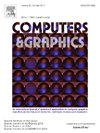利用自动适应性高频特征提取进行单图像 SVBRDF 估算
IF 2.5
4区 计算机科学
Q2 COMPUTER SCIENCE, SOFTWARE ENGINEERING
引用次数: 0
摘要
在本文中,我们要解决的任务是从单张闪光图像中估算近平面表面的空间变化双向反射率分布函数(SVBRDF)。事实证明,通过深度学习将 SVBRDF 从材料外观中分离出来是一项艰巨的挑战。在处理由点光源点亮的图像时,这种困难尤为明显,因为场景中不均匀的辐照度分布与表面相互作用,导致整个图像的亮度出现显著的全局变化。这些变化可能会被网络过度强调,并错误地嵌入到材料属性空间中。为了解决这个问题,我们提出了一种包含自动适应子带 "旋钮 "的高频路径。该路径旨在提取关键的图像纹理和细节,同时消除原始图像中存在的全局亮度变化。此外,考虑到该路径忽略了颜色信息,我们设计了一种双路径策略,从高频路径和原始图像中联合估计材料反射率。在大量数据集上进行的广泛实验证实了我们方法的有效性。在各种材料上,我们的方法都优于最先进的方法。本文章由计算机程序翻译,如有差异,请以英文原文为准。

Single-image SVBRDF estimation with auto-adaptive high-frequency feature extraction
In this paper, we address the task of estimating spatially-varying bi-directional reflectance distribution functions (SVBRDF) of a near-planar surface from a single flash-lit image. Disentangling SVBRDF from the material appearance by deep learning has proven a formidable challenge. This difficulty is particularly pronounced when dealing with images lit by a point light source because the uneven distribution of irradiance in the scene interacts with the surface, leading to significant global luminance variations across the image. These variations may be overemphasized by the network and wrongly baked into the material property space. To tackle this issue, we propose a high-frequency path that contains an auto-adaptive subband “knob”. This path aims to extract crucial image textures and details while eliminating global luminance variations present in the original image. Furthermore, recognizing that color information is ignored in this path, we design a two-path strategy to jointly estimate material reflectance from both the high-frequency path and the original image. Extensive experiments on a substantial dataset have confirmed the effectiveness of our method. Our method outperforms state-of-the-art methods across a wide range of materials.
求助全文
通过发布文献求助,成功后即可免费获取论文全文。
去求助
来源期刊

Computers & Graphics-Uk
工程技术-计算机:软件工程
CiteScore
5.30
自引率
12.00%
发文量
173
审稿时长
38 days
期刊介绍:
Computers & Graphics is dedicated to disseminate information on research and applications of computer graphics (CG) techniques. The journal encourages articles on:
1. Research and applications of interactive computer graphics. We are particularly interested in novel interaction techniques and applications of CG to problem domains.
2. State-of-the-art papers on late-breaking, cutting-edge research on CG.
3. Information on innovative uses of graphics principles and technologies.
4. Tutorial papers on both teaching CG principles and innovative uses of CG in education.
 求助内容:
求助内容: 应助结果提醒方式:
应助结果提醒方式:


